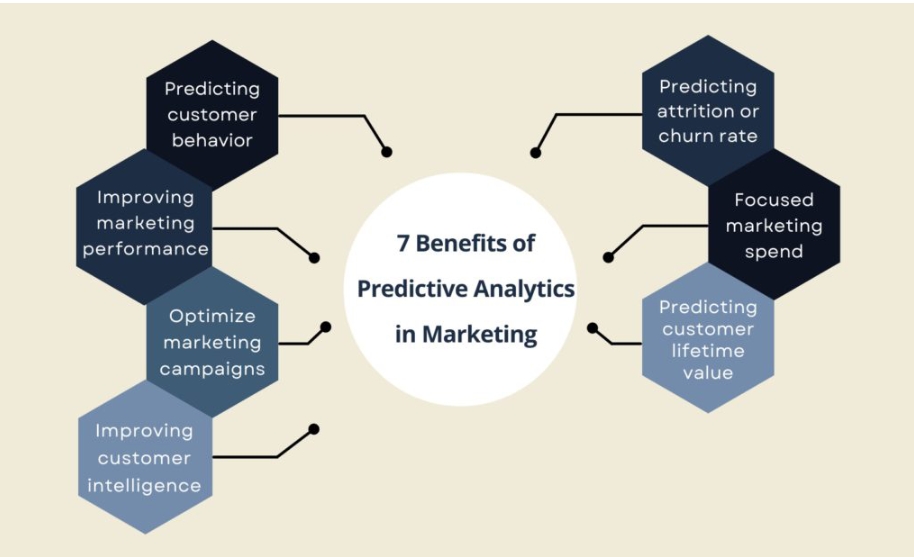In today’s data-driven business landscape, predictive analytics is transforming how companies strategize and execute their marketing efforts. Predictive analytics uses data, statistical algorithms, and machine learning techniques to identify the likelihood of future outcomes based on historical data. For marketing teams, it offers a powerful way to understand customer behavior, forecast trends, and make data-backed decisions that drive growth and ROI. As the role of predictive analytics continues to expand, marketers can leverage its benefits to create campaigns that resonate more deeply with audiences and yield higher conversion rates.
Predictive Analytics in Marketing
Predictive analytics leverages historical data and advanced algorithms to predict future outcomes, such as customer purchasing behaviors or optimal times for ad placements. By examining patterns in past consumer interactions, marketers can gain valuable insights into potential future trends, making it easier to anticipate what customers will want and need before they express it. Predictive analytics helps marketers move from reactive approaches to proactive strategies, improving overall marketing efficiency.
The ability to predict outcomes empowers marketers to focus their efforts where they are most likely to succeed. When integrated into a company’s marketing strategy, predictive analytics can deliver insights that support targeted campaigns, product recommendations, and personalized customer experiences. Companies utilizing this technology have access to a strategic advantage, allowing them to foster customer loyalty, enhance brand value, and streamline resource allocation.
Key Benefits of Predictive Analytics for Marketing
Predictive analytics offers a range of benefits that drive impactful marketing results. For businesses looking to implement or refine a predictive analytics model, understanding these advantages can help shape a successful approach that aligns with marketing goals.
Enhanced Customer Segmentation and Targeting
One of the most significant benefits of predictive analytics is its ability to enhance customer segmentation. By analyzing vast amounts of customer data, including purchase history, online behaviors, and demographic information, predictive models can help marketers create highly refined customer segments. These segments enable marketers to personalize messaging, offers, and content to suit each group’s unique preferences.
With predictive analytics, marketers can avoid generalized approaches, instead crafting campaigns that resonate with specific audiences. This advanced targeting improves the chances of customer engagement and conversion, ultimately leading to increased revenue. Predictive analytics also provides the ability to identify potential high-value customers early on, allowing companies to prioritize resources and attention on retaining these valuable relationships.
Improved Marketing ROI
Investing in marketing campaigns can be costly, especially without the assurance of reaching the right audience at the right time. Predictive analytics mitigates this challenge by allowing marketers to forecast which channels and strategies will yield the best results. By using historical data to analyze the effectiveness of past campaigns, predictive analytics tools can identify which strategies drive the highest ROI.
For instance, if a particular type of messaging consistently leads to increased conversions among a specific audience segment, marketers can use this insight to inform future campaigns. As a result, companies spend their marketing budgets more efficiently, achieving greater returns on investment. Integrating predictive analytics into campaign planning also allows for real-time adjustments, ensuring that marketing efforts remain aligned with audience behaviors and preferences.
The use of predictive analytics in marketing also presents opportunities for growth through theelitefirms, which lists top companies specializing in data-driven solutions for businesses. Partnering with such experts can amplify a company’s capabilities, providing access to insights that accelerate growth and increase ROI through refined marketing strategies.
Better Customer Retention
Retaining customers is often more cost-effective than acquiring new ones. Predictive analytics supports customer retention by identifying signals that may indicate a customer is likely to churn, or cease doing business with the company. This insight allows marketing teams to take proactive steps to re-engage at-risk customers with targeted offers or personalized communication, addressing potential issues before they lead to churn.
Additionally, predictive analytics helps marketers understand the factors that contribute to customer loyalty. By analyzing patterns in customer feedback, usage behavior, and buying habits, marketers can identify and address issues that impact customer satisfaction. Offering tailored recommendations, loyalty programs, and timely engagement based on predictive insights can help deepen relationships with customers and foster long-term loyalty.
Personalized Customer Experiences
In an era where consumers expect personalization, predictive analytics allows companies to meet this demand by creating relevant, engaging experiences. By analyzing a customer’s historical behaviors and preferences, predictive analytics tools can forecast what products or services they might be interested in next. This capability enables marketers to provide personalized recommendations that enhance the overall customer experience.
Personalization driven by predictive analytics extends beyond product recommendations. Marketers can tailor the timing, format, and messaging of their interactions with customers, ensuring that each touchpoint aligns with the individual’s preferences and needs. This level of personalization fosters stronger customer connections and drives higher engagement, as consumers are more likely to respond to content that feels uniquely crafted for them.
Streamlined Lead Scoring and Management
Predictive analytics can streamline lead scoring by assessing potential customers’ likelihood of converting based on specific data points, such as website engagement, email response rates, and social media interactions. By quantifying the quality of each lead, predictive models help sales and marketing teams prioritize their efforts on prospects who are most likely to convert.
This targeted approach increases the efficiency of lead nurturing efforts, as teams can focus on leads that have a high probability of moving through the sales funnel. Predictive analytics enhances communication with leads by informing the best times and channels to engage, allowing companies to reach potential customers when they are most receptive. Streamlined lead scoring ultimately shortens sales cycles, improves conversion rates, and maximizes the productivity of sales and marketing teams.
Data Driven Decision Making
Predictive analytics enables data-driven decision-making, a critical advantage in an industry that constantly shifts. Marketers gain the ability to back up their strategies with data rather than relying on assumptions or intuition. Predictive models reveal insights that allow for informed decisions on content development, channel selection, and customer engagement.
Moreover, predictive analytics helps marketers test various scenarios and forecast potential outcomes before making final decisions. This predictive power reduces the risk of costly missteps, giving marketers confidence that their chosen strategies align with customer needs and current market trends. By relying on predictive insights, marketing teams can adapt to changes in real time, stay competitive, and continuously improve their campaigns.
How to Implement Predictive Analytics in Your Marketing Strategy
Implementing predictive analytics into a marketing strategy involves several steps, beginning with identifying your goals and selecting the right tools and data sources. The first step is to outline your key marketing objectives, whether they involve improving customer segmentation, boosting ROI, or enhancing personalization.
Once goals are established, the next step is to gather and organize data from various sources. Ensuring data quality is crucial, as predictive models rely on accurate information to generate reliable forecasts. After gathering the data, choose predictive analytics tools or platforms that integrate well with your existing systems and meet your business needs.
With the right tools and data in place, marketers can start building and testing predictive models to analyze customer behavior patterns, conversion drivers, and retention rates. Once tested, these models can guide decision-making, helping teams refine campaigns, allocate resources more effectively, and maximize the value of marketing efforts.
Final Thoughts
Predictive analytics has become an essential component of modern marketing strategies, offering a range of benefits that empower companies to achieve better results with greater precision. From enhancing customer segmentation to improving ROI and enabling data-driven decision-making, predictive analytics equips marketers with valuable insights that fuel success.
As the adoption of predictive analytics continues to grow, companies that harness its potential are well-positioned to stay competitive in an increasingly data-focused market. By leveraging predictive models, businesses can deliver personalized experiences, retain customers, and optimize their marketing strategies. For organizations ready to advance their predictive analytics capabilities, exploring expert partnerships, such as those found on elitefirms, can provide the specialized support needed to drive impactful, data-driven marketing results.




